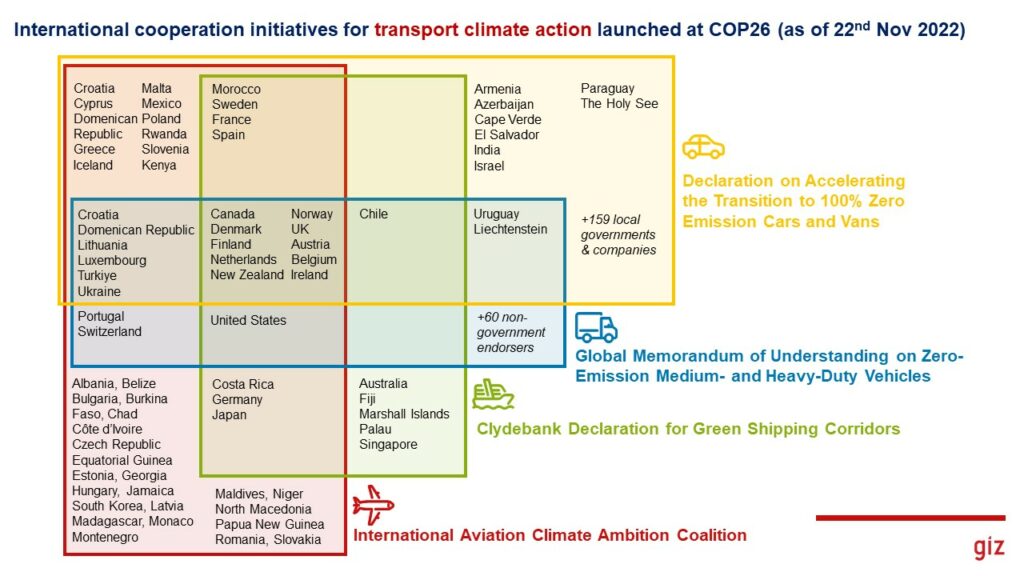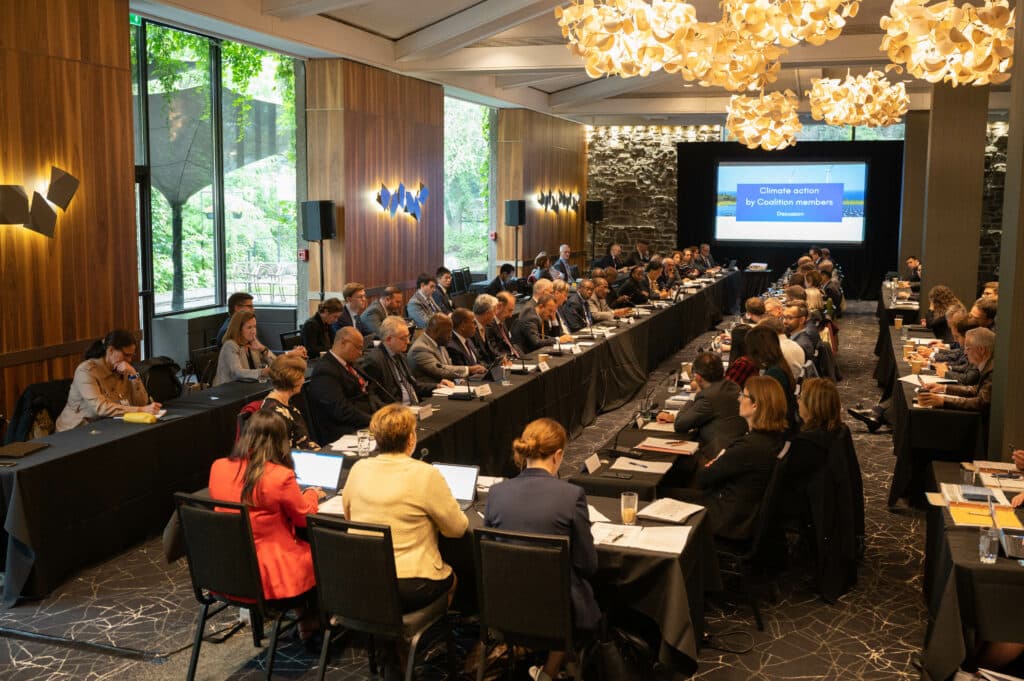
One year ago, the COP26 climate summit in Glasgow became the birthplace of four new global initiatives for transport decarbonisation. Remember, these were:
The COP27 climate summit in Egypt starting on November 7th will mark the first anniversary of these four initiatives. We at changingtransport.org were curious whether a year later these initiatives were still active. Thus, we investigated what happened since Glasgow. Have new members joined? What has been achieved so far? And what can we expect for COP27 and beyond?

Objective: The numerous public and private signatories of this declaration have committed “to work towards all sales of new cars and vans being zero emission […] globally by 2040, and by no later than 2035 in leading markets”. The declaration was designed to be a leadership group of those actors, both big and smaller countries as well as cities, companies and other entities, committed to an accelerated ZEV transition. It has been modelled on the Powering Past Coal Alliance.
Signatories: Since COP26, the membership of the declaration has grown significantly from an initial 120-130 signatories to a total of nearly 200 national and local governments, OEMs, fleet owners and other entities by October 2022. The aspiration is to get all big automotive markets on board.
Activity: The “Accelerating to Zero Coalition” will be launched as an umbrella initiative of the ZEV declaration. A soft launch already happened at the New York Climate Week on 20th September. The full, official launch is planned for COP27. The new coalition also integrates relevant workstreams of the UNFCCC High Level Action Champions (HLAC) work with Automotive Manufacturers and The Climate Group’s EV100, to avoid duplication of efforts, to pool resources, and to strategise to secure more ambitious commitments on a ZEV transition. Existing signatories will gain access to support in delivering their commitments. The UK Government is also working closely with international partners to launch a number of projects aiming to strengthen the support offer for emerging markets and developing economies in transitioning to ZEVs.
Steering: The UK government’s COP26 Zero Emission Vehicles Campaign in the Department for Business, Energy and Industrial Strategy has been working in partnership with the HLAC team, The Climate Group, and other campaign partners to undertake global outreach to get additional signatories for the declaration. The new Accelerating to Zero Coalition will be equipped with a stand-alone secretariat that is to coordinate its activities.
Objective: The Global MOU aligns leading countries on the same level of ambition for zero-emission medium- and heavy-duty vehicles (ZE-MHDVs). Country signatories strive towards a non-binding target of 30% of newly sold MHDVs being zero emission by 2030, and 100% by 2040. MHDVs are defined as those with gross vehicle weight larger than 3.5 metric tons.
Signatories: The first wave of 16 countries from Europe, the Americas and Oceania has signed the Global MOU during COP26 in 2021 and the ITF Summit in 2022. In addition, over 60 sub-national governments and businesses have since endorsed the MOU. New MOU country signatories and endorsers shall be announced at COP27. The goal is to get a high combined market share on board as well signatures from emerging economies, to send a strong signal to MHDV manufacturers.
Activity: The MOU includes a forum for coordination, collaboration and information sharing on ZE-MHDVs. The forum supports countries to achieve their ambition, share implementation lessons learned, and monitor collective progress. For example, a series of deep dive webinars has been held to inform policymakers to design policies for ZE-MHDVs by connecting countries with technology and business experts. In July 2022, a Global Roadmap for Reaching 100% ZERO-Emission Medium- and Heavy-Duty Vehicles by 2040 was established to define actions and a timeline for how to achieve Global MOU goals. On the Clean Energy Ministerial in Pittsburg in September 2022, a call to action has been released to campaign for additional country signatories.
Steering: The Global MOU is co-led by the Netherlands and CALSTART/Drive to Zero
Objective: In a nutshell, the Clydebank Declaration’s signatories aim to support the establishment of at least six green corridors by the middle of this decade, i.e. zero-emission shipping routes between two or more ports
Signatories: Singapore and Palau joined in April 2022, taking the total to 24 country signatories. The latter has been the host of the 7th Our Ocean Conference.
Activity: Since the first Green Corridor MOU has been agreed between the ports of Los Angeles and Shanghai in January, multiple other ports followed with bilateral agreements throughout 2022. For example, Gothenburg and Rotterdam , Gothenburg and Gent, Rotterdam and Singapore, or Hamburg and Halifax to name a few. It is unclear to what extent the Clydebank signatories intend to count these and other corridors towards their collective commitment, or whether they are considered as ‘complementary’. The US government has focused on defining the overall framework for green shipping corridors, and has reportedly shown interest in identifying corridors with Japan, Australia, and India.
A report from the Global Maritime Forum expects “that Clydebank signatory governments will play the ‘convening’ role in their Corridor efforts. Thus far the United Kingdom has been the most proactive government, engaging industry, commissioning evaluations and earmarking funding.” Notable, the UK recently invited funding proposals for detailed feasibility studies on UK green corridors under the second round of the Clean Maritime Demonstration Competition. The three successful proposals were announced in September, and have each been allocated a share of the £12m promised to winners of the competition to aid in the decarbonisation of the UK’s maritime sector. The UK will also be hosting a Clydebank Declaration anniversary event at COP27, in which the progress of signatories and industry towards the establishing of green corridors will be discussed by a panel featuring industry and government representatives.
To build on these efforts, the United States and Norway have announced the launch of a Green Shipping Challenge for COP27. This initiative encourages governments, ports, maritime carriers, cargo owners, and others in the shipping value chain to come forward with concrete steps that will help put the international shipping sector on a credible pathway this decade toward full decarbonisation no later than 2050.
Steering: The UK organized and hosted the launch of the Clydebank Declaration at COP26 and continues to be a leader in galvanising action on the establishment of green corridors, but as noted above, the Declaration is a jointly signatory-led initiative.

Objective: The International Aviation Climate Ambition Coalition was launched with a declaration at COP26 aimed at galvanizing support for high ambition on aviation decarbonisation, including through ICAO. Among several commitments, members of the Coalition agreed to working through ICAO to support the adoption of a long-term aspirational goal for international aviation that was consistent with the temperature goal of the Paris Agreement. This net-zero 2050 goal was successfully adopted at the recent 41st ICAO Assembly. Other commitments include ensuring the maximum effectiveness of ICAO’s Carbon Offsetting and Reduction Scheme for International Aviation (CORSIA) promoting development and deployment of sustainable aviation fuels, and capacity building.
Signatories: The Coalition’s membership has more than doubled since its launch, going from 25 to 59 countries, including members in all world regions with Chad, Niger and Papua New Guinea the latest to sign up.
Activity: The Coalition was especially active at this year’s ICAO Assembly, making significant efforts to secure agreement to a new goal for international aviation of net zero CO2 emissions by 2050 – an historic milestone for the sector. It submitted a formal working paper calling for high ambition in setting the new goal, maintaining the integrity and ambition of CORSIA, and highlighting the importance of capacity building support. On the eve of the Assembly, Coalition states, represented by Ministers and senior officials, gathered alongside industry and NGOs to reiterate the urgency of climate action and the Coalition’s commitment to continued international cooperation in decarbonising international aviation. Coalition members then worked together throughout the subsequent ICAO negotiations and were delighted by the positive outcomes and widespread support for climate ambition. The Coalition continues to welcome new members and will be considering its priorities for 2023 following the success of the ICAO Assembly.
Steering: The UK devised and launched the Coalition in its capacity as COP26 President and has played a key role in convening the group, but members are collectively responsible for its work programme and key decisions.
Conclusion
All four initiatives are very much alive. They didn’t make major headlines since COP26 but have been busy expanding and diversifying their membership. The total number of countries being member to one or several initiatives has climbed from 49 to 76 within one year, plus dozens of non-governmental and subnational signatories and endorsers (and plus countries which already were in the original group of 49 yet have joined further initiatives). This is a strong sign of international engagement for the net-zero transition in transport.
Each initiative goes a different way in delivering on its goals and in serving its members, ranging from influencing multilateral negotiations (aviation coalition), to knowledge exchanges and roadmaps (ZE-MHDV MOU), preparing concrete projects (Clydebank Declaration) and coordinating activities, amplifying messages and securing more commitments (e.g. ZEV Declaration).
What unites them is their agenda of strengthening ambition and implementation. They harness collective commitment for net-zero transport systems and build mutual support. They send strong signals of policy support for transforming the transport sector, which is particularly important in the hard-to-abate sectors of shipping, aviation and road freight. Shipping and aviation are not directly included in the Paris agreement due to their transnational nature, which is why the Aviation Coalition and the Clydebank Declaration also serve to bridge between UNFCC, ICAO and IMO.
The UK continues to play a leading role in the success of the COP26 initiatives. We are optimistic that the momentum will carry on beyond COP27. Hopefully with more economies from Asia, Latin America and Africa coming on board. We look forward to continuing supporting partner countries to deliver on their international commitments.
Acknowledgements
A huge thank you to the following individuals who play leading roles in the above initiatives and have provided us with insights and feedback for this article:
And to Felix Klann for assisting in the update of the COP26 initiatives diagramme as well as to Kyona Eichhorn for her desk research.
You are currently viewing a placeholder content from X. To access the actual content, click the button below. Please note that doing so will share data with third-party providers.
More Information